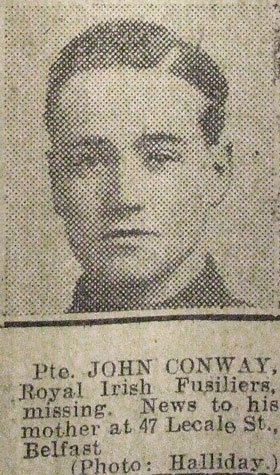Lance Corporal John Conway

John Conway was born in the Shorncliffe Army Camp, Kent, on 2 December 1897, the second of nine children of Royal Irish Rifles sergeant James Conway and his wife Margaret (née McKinney (or McKinlay)). His father served in the Rifles from 1888 to 1907, including a year in South Africa during the Boer War, when he was mentioned in despatches. By the time of the 1911 Census, John was living at 43 Selby Street, Belfast, with his parents and sibilings and working as a message-boy. They later moved to 47 Lecale Street.
Conway enlisted in the North Irish Horse on 11 January 1915 (No.1395). He embarked for France with F Squadron on 17 November 1915. It is likely that he had understated his age, because he was not yet 18.
In June 1916 F Squadron joined with C Squadron and the 6th (Inniskilling) Dragoons Service Squadron to form the 2nd North Irish Horse Regiment, serving as corps cavalry to X Corps until September 1917, when the regiment was disbanded and its men transferred to the infantry. Most, including Conway, joined the 9th (Service) Battalion, Royal Irish Fusiliers – renamed the 9th (North Irish Horse) Battalion – on 20 September. Conway was issued regimental number 41486 and posted to A Company. He probably saw action with the battalion in the Battle of Cambrai in November and December 1917.
Conway was one of the many of the battalion reported as missing following the retreat from St Quentin from 21 to 28 March 1918 during the German spring offensive. It was later reported that he had been made a prisoner of war. He was released soon after the Armistice, returning to England on 27 November 1918.
Conway re-enlisted in the Royal Irish Fusiliers on 20 February 1920 (No.33956, then No.7041937). He was discharged on 19 February 1922.
Conway's father also served during the war, in the Royal Irish Rifles and then in France with the Indian Labour Corps, reaching the rank of company sergeant-major.
Image from the Belfast Evening Telegraph kindly provided by Nigel Henderson, Researcher at History Hub Ulster (www.greatwarbelfastclippings.com).
